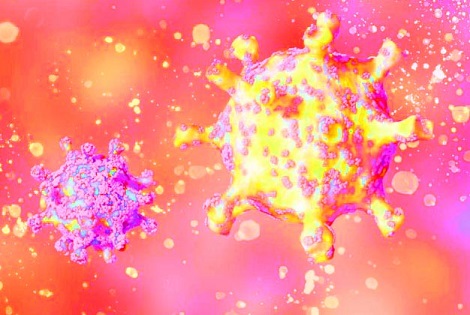German study finds that Oxysterol-binding protein plays a key role in SARS-CoV-2 replication
Nikhil Prasad Fact checked by:Thailand Medical News Team Jul 25, 2024 9 months, 15 hours, 41 minutes ago
COVID-19 News: In a groundbreaking discovery, researchers have uncovered crucial details about how SARS-CoV-2, the virus responsible for COVID-19, replicates within human cells. This breakthrough focuses on the oxysterol-binding protein (OSBP) and its pivotal role in coronavirus replication. The findings open new avenues for developing antiviral drugs that could potentially combat COVID-19 and other coronaviruses.
 German study finds that Oxysterol-binding protein plays a key role in SARS-CoV-2 replication
German study finds that Oxysterol-binding protein plays a key role in SARS-CoV-2 replication
The study, spearheaded by scientists from prestigious institutions such as Ludwig-Maximilians-University Munich, the German Center for Infection Research, Charité - Universitätsmedizin Berlin, Helmholtz-Zentrum München, and the University of Iowa-USA, highlights the intricate mechanisms through which SARS-CoV-2 manipulates OSBP to ensure its survival and proliferation.
Understanding OSBP
Oxysterol-binding protein (OSBP) is a lipid transporter critical for maintaining cellular functions. It mediates the exchange of cholesterol and phosphatidylinositol-4-phosphate (PI4P) between the Golgi apparatus and the endoplasmic reticulum (ER). Cholesterol is essential for maintaining cell membrane integrity and signaling, while PI4P is a key molecule in various cellular processes. OSBP’s ability to shuttle these lipids between different cell compartments ensures that cells function correctly.
In uninfected cells, OSBP plays a vital role in lipid homeostasis, helping in the distribution of cholesterol to membranes where it is needed. However, in cells infected with certain viruses, including SARS-CoV-2, OSBP's role expands. It becomes a crucial player in the formation of double-membrane vesicles (DMVs), which are essential for viral replication.
The Role of OSBP in Coronavirus Replication
This
COVID-19 News report covers the study that explores how SARS-CoV-2 hijacks OSBP to facilitate its replication. The research led by Dr Yue Ma-Lauer, Dr Pengyuan Li, and their colleagues demonstrates that OSBP significantly promotes the replication of coronaviruses by interacting with several viral non-structural proteins (Nsps) and other viral components.
The study reveals specific interactions between OSBP and SARS-CoV-2 Nsps, particularly Nsp3, Nsp4, and Nsp6. These proteins are involved in forming DMVs, which are crucial for viral replication. The interactions between OSBP and these Nsps ensure that the virus can replicate efficiently within the host cell. By targeting and manipulating OSBP, the virus effectively creates a favorable environment for its proliferation.
Experimental Methods
To uncover these findings, the research team used various advanced techniques. They employed plasmid transfection in cell cultures to introduce and express viral and host proteins within the cells. Yeast two-hybrid assays were used to identify protein-protein interactions, while co-immunoprecipitation assays confirmed these interactions within human cells. Immunofluoresce
nce microscopy allowed the researchers to visualize the localization of these proteins within the cells, providing insights into how SARS-CoV-2 manipulates OSBP for its replication.
Key Findings of the Study
The researchers employed a combination of biochemical and cellular assays to elucidate the interactions between OSBP and SARS-CoV-2 proteins. They discovered that OSBP binds to the ER membrane via VAMP-associated protein B (VAP-B). The study showed that SARS-CoV-2 proteins Nsp3, Nsp4, and Nsp6 disrupt this interaction, which is essential for the formation of DMVs. Specifically, Nsp3 was found to completely block the binding between OSBP and VAP-B, while Nsp6 partially impaired it.
Moreover, the study identified SARS-CoV-2 proteins orf7a, orf7b, and orf3a as additional targets of OSBP. These interactions contribute to the stabilization of these viral proteins, further aiding in the virus's replication process. The researchers also explored a novel OSBP-binding compound named ZJ-1, which demonstrated potent antiviral effects by significantly reducing OSBP levels and inhibiting viral replication.
Details on OSBP’s Role and the Novel Compound ZJ-1
The study findings underscore the essential role of OSBP in the replication of SARS-CoV-2 and potentially other coronaviruses. By interacting with viral proteins, OSBP facilitates the formation of DMVs, providing a site for viral replication. The discovery of the novel compound ZJ-1 adds a promising dimension to the research. ZJ-1, a simplified analog of a natural product known as OSW-1, was designed to inhibit OSBP effectively. In the study, ZJ-1 was shown to reduce OSBP levels significantly and exhibited strong antiviral activity against various coronaviruses, including SARS-CoV-2.
The researchers detailed how ZJ-1 treatment reduced the protein levels of OSBP in several cell lines, leading to a marked decrease in viral replication. The compound’s ability to deplete OSBP highlights its potential as a broad-spectrum antiviral agent. In addition to SARS-CoV-2, ZJ-1 was also found to inhibit the replication of other coronaviruses, such as HCoV-229E and HCoV-OC43, demonstrating its wide-ranging efficacy.
Implications for Future Research and Treatment
The discovery of OSBP's role in coronavirus replication and the identification of ZJ-1 as a potent OSBP inhibitor have significant implications for future research and treatment. By targeting OSBP, it may be possible to develop new antiviral therapies that can prevent the virus from replicating within human cells. This approach could provide a broad-spectrum antiviral strategy, not only for COVID-19 but also for other coronaviruses that pose a threat to global health.
The study’s findings suggest that disrupting the interaction between OSBP and viral proteins could effectively inhibit viral replication. This approach offers a novel therapeutic target that could complement existing treatments and help mitigate the impact of coronavirus infections.
Conclusion
This groundbreaking research highlights the critical role of OSBP in coronavirus replication and identifies it as a promising target for developing antiviral therapies. The novel compound ZJ-1 demonstrates potent antiviral activity by targeting OSBP, opening new avenues for broad-spectrum antiviral treatments.
The study findings were published in the peer-reviewed journal: Frontiers in Cellular and Infection Microbiology.
https://www.frontiersin.org/journals/cellular-and-infection-microbiology/articles/10.3389/fcimb.2024.1383917/full
For the latest
COVID-19 News, keep on logging to Thailand Medical News.
Read Also:
https://www.thailandmedical.news/news/austrian-scientists-claim-that-high-density-lipoproteins-can-be-used-as-antivirals-against-covid-19-infections
https://www.thailandmedical.news/news/covid-19-news-study-of-long-term-metabolic-alterations-in-recovered-sars-cov-2-patients-reveals-up-to-170-dysregulations-two-years-on
https://www.thailandmedical.news/news/covid-19-antivirals-japanese-study-shows-that-oxidized-cholesterol-derivatives-or-oxysterol-shows-antiviral-activity-against-sars-cov-2
https://www.thailandmedical.news/news/covid-19-news-sars-cov-2-infections-lead-to-buildup-of-oxysterols-in-erythrocytes-which-can-be-used-as-a-biomarker-for-disease-severity
